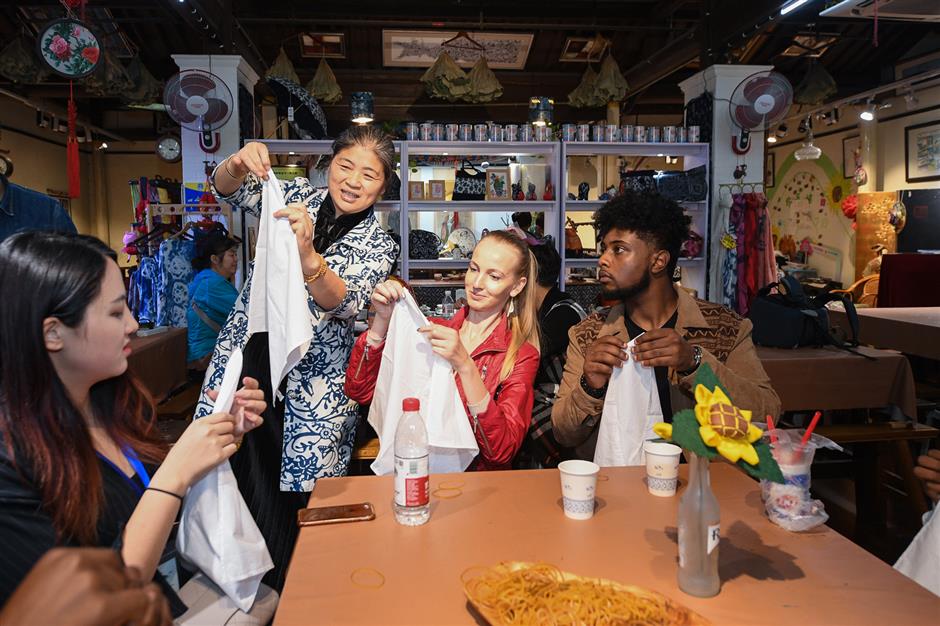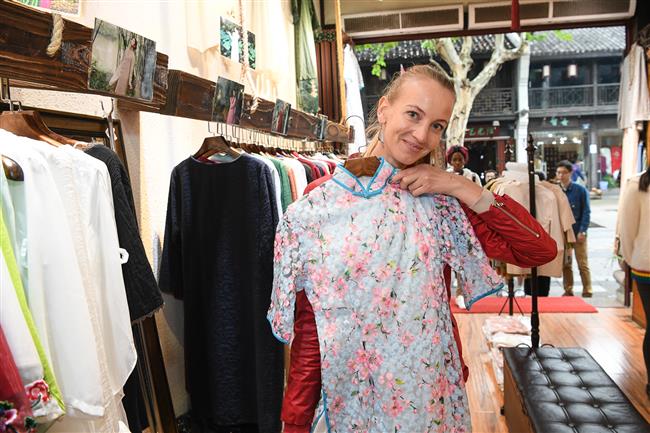World leisure expo shows off city's treasures
The 3rd World Leisure Expo kicked off last Friday _ a platform to explore global leisure concepts and cultural studies, and keep participants abreast with developments throughout the industry.
A highlight of the expo _ which occurs every five years _ was the "Route of Leisure Experience Demonstration Area." About 80 people from America, Britain, Canada and Singapore were invited to experience Hangzhou style and its attractions.
The three-day tour covered West Lake, the Grand Canal, Lingyin Temple, Hefang Street, Yuhuang Hill and the Qiantang River.
It was aimed at showcasing Hangzhou's thousands of years of history and the wealth of attractions it has to offer visitors.

Expats experience dyeing indigo clothes in Xin Yi Fang Workshop.
On Hefang Street, a key part of the tour, the guests visited a famous traditional Chinese medicine drugstore and a craft studio, experienced dyeing cloth in a workshop to learn about tradition and strolled along the historic street to experience the vibes.
This street is popular with tourists as it is dotted with time-honored brands and handicraft outlets. The Zhu Bingren Copper Sculpture Art Museum and the Hu Qing Yu Tang TCM Museum underscore the city's still-vibrant traditional industries.
Zhu is regarded as the father of modern Chinese copper and bronze art and his famous works include the bronze hall in Lingyin Temple and the Leifeng Pagoda, the Mahavira Hall at E'mei Jinding (Golden Top of E'mei Mountain) in Sichuan Province, and the bronze tower in Guilin, Guangxi Zhuang Autonomous Region.
The private museum is the first of its kind in China. It displays Zhu's sculptures like copper bridges, buildings, temples, pagodas and halls. The metal comes alive in Zhu's hands.
With smooth lines, dedicated carving and lifelike effects, he endows metal with cultural, religious, artistic and architectural meaning.
Two millennia ago, bronze was used to make ritual royal vessels. But through the centuries, it was replaced by other metals and largely disappeared until Zhu revived the skills in China.
His techniques were added to China's National Intangible Cultural Heritage List in 2009.
Hangzhou is famous for its traditional Chinese medicine practitioners, clinics and pharmacies. Time-honored brands include Hu Qing Yu Tang, Zhang Tong Tai and Fang Hui Chun Tang.
Hu Qing Yu Tang is the only national-level TCM museum in Hangzhou and considered the "king of medicine" in the southern part of the lower reaches of the Yangtze River. It receives endless streams of patients from Hangzhou and other cities every day.
The museum lies on the original site of the pharmacy, which was built in 1874 by renowned businessman Hu Xueyan of the Qing Dynasty (1644-1911). Historians consider it one of China's best-preserved business establishments from the late Qing Dynasty.

Foreigners visit the Southern Song Imperial Street.
Nowadays, the centuries-old pharmacy has expanded into a complex covering more than 4,000 square meters with a museum, a working clinic, a pharmacy workshop and a restaurant.
Doctors treat patients at the clinic, workers fill prescriptions and compound medicine pills. Exhibitions in the museum showcase the history and fundamentals of TCM and thousands of specimens of herbs, along with descriptions of their therapeutic uses. The restaurant serves healthy and delicious food that is prescribed in various diet therapies.
Hefang Street is in the original center of the Southern Song Dynasty (1127-1279) imperial city, when Hangzhou was its capital. Years ago, the ancient Southern Song Imperial Street was unearthed nearby, and then the local government invited Pritzker Architecture Prize winner Wang Shu to restore it.
With more than 1,000 years of history, nowadays the imperial street is a fashion and vintage-accented strip that includes chic stores, restaurants and teahouses. It features old gray brick and cement walls, paved with dark-gray and light-gray flagstones.

A foreign girl tries on qipao (cheongsam).
The two streets made up one of the oldest areas in the city. The Yi Xin Fang Workshop is nestled there. It has carried on the old techniques of dyeing indigo clothes, or Lanyin huabu (蓝印花布), which originated in the Southern Song Dynasty and boomed during the Ming (1368-1644) and Qing dynasties.
In ancient times, people used the common indigo plant to dye white cotton dark blue.
The colors and patterns were simple and plain compared to what's available now, but locals began to make these batik-like textiles for commoners. Tablecloths, scarves, quilt covers, cushions, curtains were popular.
The social significance has faded over time, but it remains a cultural heritage.
Some fashion designers have used the style to design chic and trendy apparel. Today, traditional dyeing workshops are popular hangouts for hipsters looking for a taste of tradition.
















